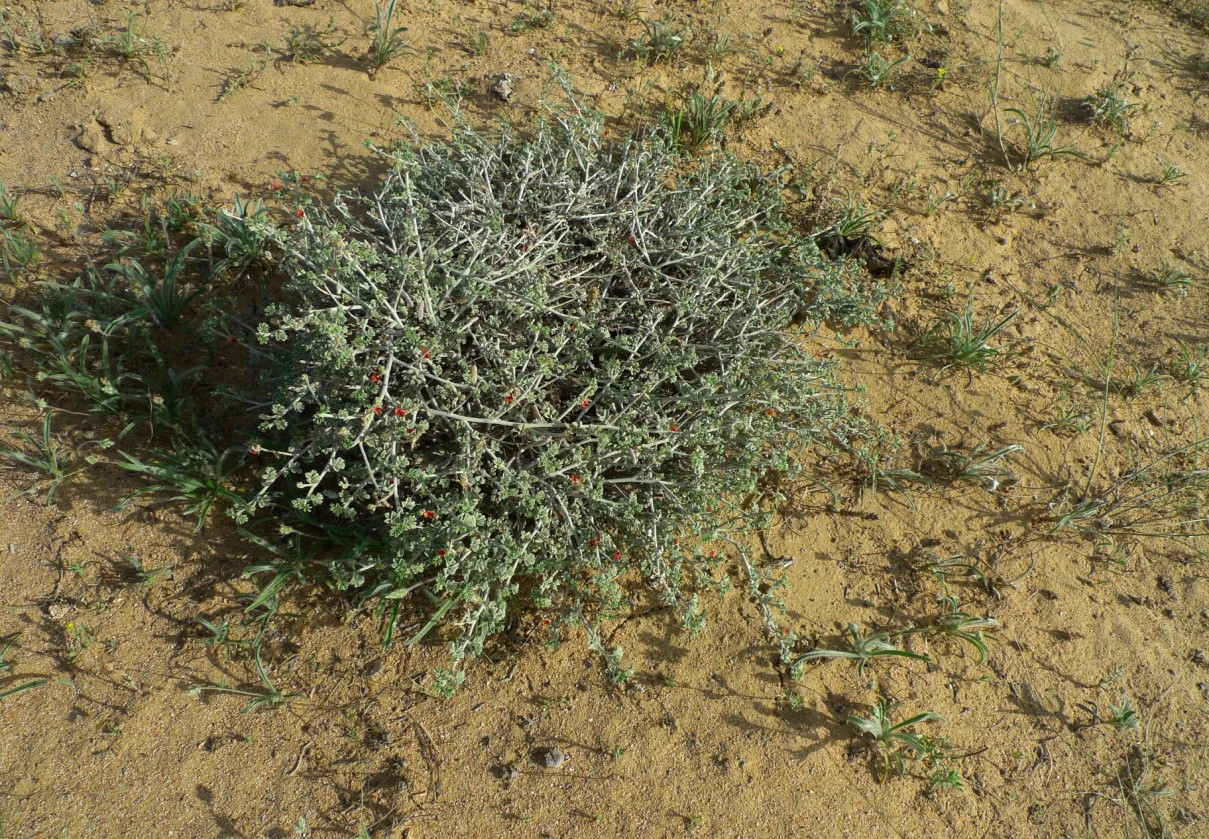
Indigofera intricata / بيشة
Indigofera pseudointricata
Haweer, Neela, Neely, Wadnah, Rasem, Hesaar
Indigofera
Baysha
Fabaceae

Aerial parts
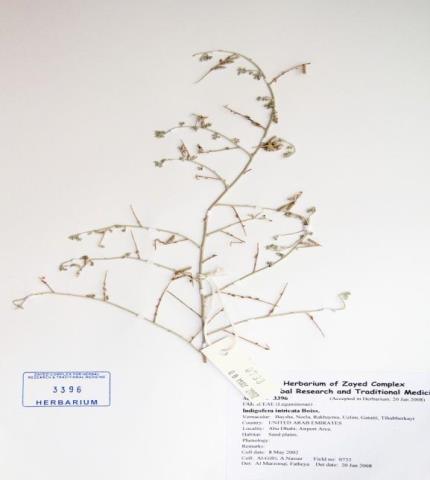
Herbarium specimen
Ethnobotanical Characteristics
Description
The plant habit is procumbent to prostrate, perennial. Stem hoary with appressed hairs, lateral branches spinescent. Leaf imparipinnate compound, rachis less than 5 mm long, leaflets 3-7, opposite to subopposite, 2.5-4.0 mm long, 4 mm or less broad, obovate, obtuse, truncate-retuse, mucronate, densely appressed-pubescent on both sides, stipules lateral, 1.5-2 mm long. Inflorescence an axillary raceme, 2-5 cm long, axis spinescent. Bract 1.5 mm long. Pedicel 0.5-1 mm long. Calyx 3-3.5 mm long, densely pubescent, hoary, teeth 2.5 mm long. Vexillum 4-4.5 mm long, externally pubescent. Fruit 10-14 mm long, 2 mm broad, densely pubescent, up to 5-seeded. (Jongbloed, 2003, eFloras, Mandaville, 1990).
Habitat and Distribution
Sandplains. Found in Persia, Arabian Peninsula and Pakistan. In the UAE common and widespread between Abu Dhabi, Al Ain and Sharjah.
Part(s) Used
Whole Plant
Traditional & Medicinal Uses
Used to treat burns and wounds, by burning it and uses the ashes to fill the infected skin area / wound (El- Ghonemy 1993).
Pharmacognosy and Phytochemistry
Plant material Studied
Dried leaflet
General appearance
Leaflets are rounded and small in size (about 2-3 mm in length). The upper surface of the leaflet is silvery grey, while the lower surface is light grayish-green. It is brittle, usually found as broken pieces.
Microscopical characteristics
The leaf is small, and on both surfaces, mid-rib and margins are densely covered with numerous T-shaped covering trichomes, each with two long tapering ends but they are mostly found on the upper epidermis. Cells of both epidermises are small in size and polygonal in outline. Stomata are few; they are anomocytic and are mostly found at the lower epidermis. The leaflet is isobilateral with one layer of narrow compactly packed palisade cells beneath each epidermis. Palisade tissues contain cells that are rich in yellowish-orange to orange-coloured materials nearly rounded in shape with thin cell walls. They also contain cells which are rich in reddish-brown materials. Prisms of calcium oxalate are observed in both palisade and spongy mesophyll cells. They spongy mesophyll cells are traversed by slender vascular tissues whose vessels are mostly spirally or scalariformly thickened.
Dried stem and branches
General appearance
The stem and branches are silvery grey with a pinkish tint. The branch is slender, thin (to 1.5 mm in diameter), almost cylindrical in outline. It is brittle and easily broken. A transverse section of the stem shows that it is nearly cylindrical. The epidermis consists of a thin layer of dark brown to violet oblong cells that protrude into small arches. The epidermis also bears many different kinds of covering trichomes; these include T-shaped trichomes with tapering ends in addition to normal conical shaped trichomes. The cortex is composed of a number of layers; the outermost layers are composed of compressed parenchyma cells, while those surrounding the vascular tissues (endodermis) have wide lumens and thick cell walls. All cells are either orange or light brown in colour indicating that they are rich in coloured pigments. Groups of small-sized cells in the cambium layer form the xylem tissues, which occupy small thickened area, and they are highly lignified. The radiating medullary rays separate the vascular tissues. The pith occupies a central position, and it is composed of parenchyma cells of different shapes and sizes; some of these contain dark brown materials.
Powdered plant material
The pounded aerial parts of the plant look heterogeneous, coarse light yellow to a grayish-yellow in colour. It is odorless, but it has a slight mucilaginous astringent taste. Microscopically, the sample shows numerous detached and few attached T-shaped and conical covering trichomes with those of the stem and branches much larger and having warted walls. The sample also shows the bright green leaf fragments both in surface and cross-sectional views, exhibiting the isobilateral character of the leaf and the calcium oxalate and reddish-brown contents of the mesophyll cells. Also shown are the polygonal epidermal cells in addition to the light orange cortical tissues of the stem and branches.
Parts studied
leaf
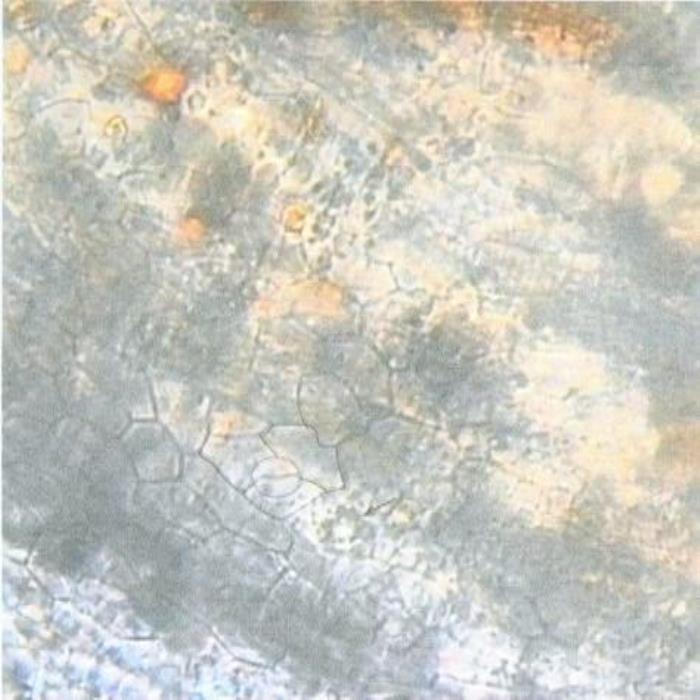
A) Lower surface of leaflet

B) Covering trichomes
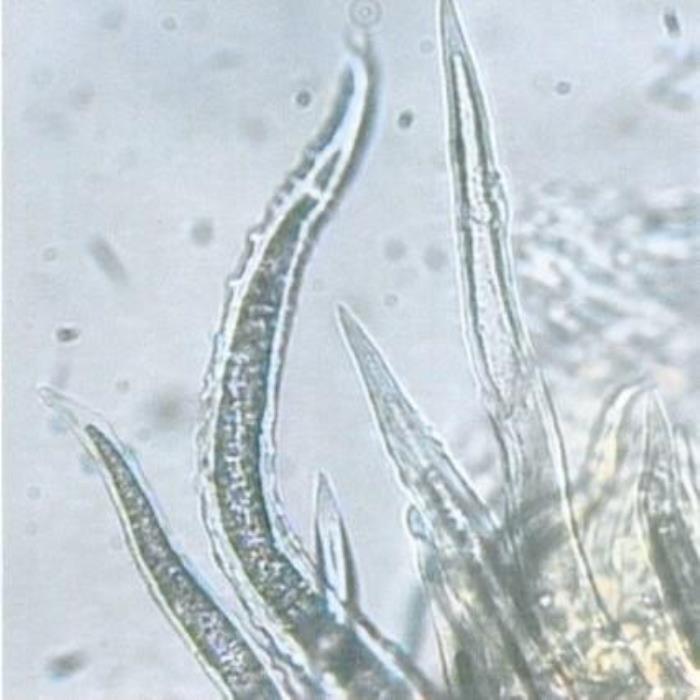
C) T-shaped covering trichomes
- A. Lower surface of a leaflet showing an anomocytic stomata surrounded by three subsidiary cells and a cicatrix left by the detachment of a covering trichome.
- B. Whole leaf general outlook as it is densely covered with T-shaped covering trichomes each with two tapering ends at its abaxial surface (upper epidermis).
- C. A group of T-shaped covering trichomes showing only one of their tapering ends; they have warty cuticle thick cells walls and wide lumens.
Chemical Constituents
It contains alkaloids, steroids, tannins, flavonoids (flavones, flavanols or xanthones) and saponins, but it does not contain anthraquinone glycosides or the greenish-blue dye as in Indigofera tinctoria (ZCHRTM-unpublished results).
The following chemical studies have been carried out on the aerial part of the plant Indigofera intricata (Quality Control methods, 1998; Evans, 1996; ZCHRTM unpublished work) :
Physicochemical constants
Loss of weight on drying 105°C: 10.10
Absolute alcohol solubility : 2.40
Water solubility : 10.80
Successive extractives (%)
Petroleum ether (60-80) °C : 1.60
Chloroform : 0.90
Absolute alcohol : 5.40
Ash values (%)
Total ash : 8.50
Water soluble ash : 1.30
Acid insoluble ash (10% HCl) : 0.20
pH values (aqueous solution)
pH of 1% solution : 8.526-8.528
pH of 10% solution : 8.213-8.222
Elemental analyses
Ash values (British Herbal Pharmacopeia)
Assay and identification of element (AOAC International)
|
Apparatus |
(AA-6800 Shimadzu-Flame method) |
||||
|
Element |
Std. conc. µg/ml (ppm) |
Sampleconc.mg/ml |
Sample absorbance |
Actual conc.mg/ml |
Actual conc.(%) |
|
Cr |
1, 2, 4 |
10 |
0.0076 |
0.00679 |
0.000679 |
|
Zn |
0.25, 0.5, 1 |
10 |
0.1304 |
0.01127 |
0.001127 |
|
Cu |
1, 2, 4 |
10 |
0.0251 |
0.0112 |
0.00112 |
|
Fe |
1, 2, 4 |
10 |
0.1282 |
0.09080 |
0.009080 |
|
K |
1, 2, 4 |
1 |
0.4926 |
8.914 |
0.8914 |
|
Pb |
1, 2, 4 |
10 |
0.0000 |
0.0000 |
0.0000 |
|
Cd |
0.25, 0.5, 1 |
10 |
0.0013 |
0.00013 |
0.000013 |
|
Ca |
5, 10, 20 |
10 |
0.1143 |
3.6690601 |
0.3669060 |
UV Spectral studies
|
Ultraviolet Spectrum (USP) |
||||
|
Apparatus |
Milton Roy Spectronic Genesys 5 Spectrophotometer - Milton Roy. |
|||
|
Sample conc. (mg / ml) |
Solvent |
λ max (nm) |
λ min (nm) |
Abs.( λ max - λ min) |
|
5 |
Intestinal Fluid simulated without pancreatic pH=7.50.1 |
277 |
259 |
1.523 - 1.336 |
|
3.98 |
Gastric Fluid simulated without pepsin pH =1.20.1 |
280 |
262 |
1.004 - 0.833 |

Intestinal Fluid simulated without pancreatic

Gastric fluid simulated without pepsin
Chromatographic Studies
Thin layer chromatography (Wagner and Bladt, 1996)

A

B

C

D
TLC fingerprint of Petroleum ether 60-80°C (track 1) and Methanol extract (track 2)
|
Mobile phase Fig. |
A&D |
: |
Ethyl acetate, methanol, water (100:13.5:10) |
|
|
B&C |
: |
Toluene, ethyl formate, formic acid (5:4:1) |
|
Detection |
A |
: |
UV 254nm |
|
|
C&D |
: |
UV 366nm |
|
Derivatization |
B |
: |
Vanillin-Sulphuric acid –vis. |
Pharmacological and toxicological studies
The following information was reported in the Literature about the plant:
The species Indigofera intricata has been tested for its antibacterial and antifungal activity (Dahot, 1999). In a test tube trial, this plant showed significant activity against certain types of bacteria and fungi. This research is still in its preliminary stages (Shahjahan, 2005). The protective effect of I. oblongifolia was evident from lowering of levels of marker enzymes in serum and maintenance of antioxidant status in the liver (Shahjahan, 2005).
Chloroform soluble fraction of Indigofera intricata, along with beta sitosterol (3) and 3-hydroxybenzoic acid (4) species showed significant activity against enzyme lipoxygenase, while the second compound showed moderate inhibition against Butyrylcholinesterase (BChE) (Greig, 2005).
Considering that antioxidant activity is an important mechanism of cytoprotection, the antioxidant properties of the alkaloids of Indigofera truxillensis leaves were evaluated on rat gastric mucosa. The ethanol-induced gastric ulcer revealed that the gastro-protective mechanisms of indigo include non-enzymatic antioxidant effects, and the inhibition of polymorphonuclear neutrophil activity partially protects the gastric mucosa against ethanol-induced damage (Farias-Silva,2007).
Hepatotoxicity induced in male Wistar rats using CCl4 significantly lowered the levels of marker enzymes in serum and maintenance of antioxidant status in the liver. Such effects were reflected in lowered levels of TBARS, increased levels of GSH, and increased activities of SOD, CAT, and GPx. These results show the protective effect of I. intricata and suggest the antioxidant property of the extract (Shahjahan, 2005).
The species Indigofera spicata, however, is poisonous and consumption of which has reportedly killed cattle and other animals (Miller, 1973; Finnegan, 1965), and has caused birth defects in rats (Pearn, 1970). Other species have also been found to be lethal (Hegarty ,1988; Miller, 1973). For this reason, it is important to avoid ingesting Indigofera unless it has been harvested and processed by expert, reliable individuals.
The aqueous leaf extract of Indigofera suffruticosa was investigated for the cytotoxic and antitumor effects. It did not exhibit cytotoxicity against HEp-2 (human epidermoid cancer cell) cell lines (Vieira 2007).
The following pharmacological and safety studies were carried out on the aqueous plant extract of Indigofera intricata at ZCHRTM Labs. (Derelanko 2002; Han, 2003).
|
ACTIVITY |
RESULTS |
|||
|
Strong |
Moderate |
Mild |
Negative |
|
|
Analgesic (Hot plate & Writhing) |
|
|
|
√ |
|
Anti-inflammatory (Paw edema) |
|
|
|
√ |
|
Anticonvulsant |
|
|
√ |
|
|
Effect on onset and duration of pentobarbitone sleeping time ↑ |
√ |
|
|
|
|
Effect on rabbit jejunum |
√ |
|
|
|
|
Effect on rat fundus |
√ |
|
|
|
|
Effect on Guinea pig ileum |
|
|
√ |
|
|
Effect on rat detrusor muscle |
|
√ |
|
|
|
Effect on Guinea pig tracheal chain |
|
|
√ |
|
|
Effect on right rat atria |
√ |
|
|
|
|
Anesthetized rat (BP & HR) |
|
|
|
√ |
|
Antithrombotic effect |
|
|
|
√ |
|
Biochemical studies (TP & ALP) ↑ |
|
√ |
|
|
|
Hematological studies |
|
|
|
√ |
|
Locomotor activity test |
|
|
|
√ |
|
Motor co-ordination (grip strength & motor activity |
|
|
|
√ |
|
Rectal temperature |
|
|
|
√ |
|
Body weight ↓ |
|
|
√ |
|
|
Vital organs |
|
|
|
√ |
|
Mortality |
|
|
|
√ |
|
LD50 |
>10g/kg |
|||
Summary of the results
Aqueous extract of the plant caused a sharp relaxation (0.5 ml of 100 mg/ml solution) and inhibition of spontaneous contraction in rabbit jejunum. The study provided the basis for some of the traditional uses of the plant in hyperactive gut states. The presence of antispasmodic activity showed antidiarrheal/ anti-secretory activity. It might produce relief of gastrointestinal spasm and improve the digestion. It produced significant increase in the resting tension, which was blocked by atropine in guinea-pig isolated ileum.
The plant extract prolonged the sleeping time of mice, perhaps due to the production of pentobarbital sodium known to cause significant sedative–hypnotic effect. The assessment of the anti-convulsant activity showed that the percentage of mortality was reduced in the treated groups compared to the control groups, but was not significant. The extract produced mild relaxation (~10%) in the histamine-pre contracted tracheal chain showing anti-asthma activity.
Indigofera extract at the dose of 0.5g and 1g/kg showed no significant analgesic activity in three mice experimental models tested, but showed pro-inflammatory activity. The extract showed no change in arterial blood pressure, and the heart rate remained unchanged, while the force of contraction increased. It was not affected by propranolol in isolated rat atria method. In the biochemical study, the extract moderately elevated the total protein and the alkaline phosphatase enzymes.
Acute toxicity studies using aqueous extract (3200, 6400, 10,000 mg/kg, p.o.); In the gross behavioral studies, the water extract of Indigofera did not produce any abnormal signs, symptoms or death during the observation period, at the doses studied. In the LD50 study, no mortality was observed at the doses studied. LD50 was deduced to be >10 g/kg. No significant change in any of the parameters observed as compared to control. No significant change was found in hematological parameters, as compared to the control group. However, there was a significant decrease in prothrombin as compared to the control values.
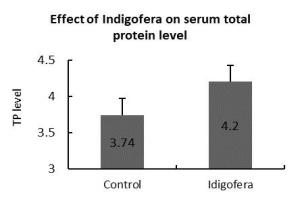
Effect on total protein level
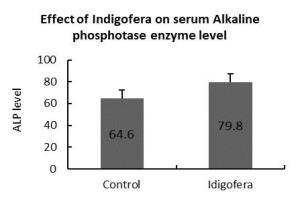
Effect on Alkaline phosphatase level

Effect on pentobarbitone sleeping time
Antimicrobial activity
The aqueous extract of the whole plant was tested against Mycobacterium smegmatis, C. tropicalis, different strains of E. coli (Including ATCC UN 109) and different strains of Staphylococcus aureus (Including ATCC 257), different strains of Methicillin Resistant Staphylococcus aureus MRSA, and different strains of ESBL-producing K. pneumonia, E. coli, Pseudomonas aeruginosa. The extract had a very strong antibacterial activity against Staphylococcus aureus and Mycobacterium smegmatis.
References
- Dahot MU.( 1999 )Antibacterial and antifungal activity of small protein of Indigofera oblongifolia leaves. J Ethnopharmacol.64:277–282.
- Elisangela Farias-Silva (2011) , Indigofera suffruticosa, Mill as new source of healing agent: Involvement of prostaglandin and mucus and heat shock proteins Journal of Ethnopharmacology, Volume 137, Issue 1, 1
- September 2011, Pages 192-1988
- El-Ghonemy, A. A. (1993). Encyclopedia of Medicinal plants of the United Emirates. 1st Edition. University of U.A.E.
- Flora of Pakistan; www.efloras.org
- Jeymesson Raphael Cardoso Vieira Ivone Antônia de Souza, Silene Carneiro do Nascimento, and Sônia (2007) Pereira Leite Indigofera suffruticosa: An Alternative Anticancer Therapy, Volume 4, Issue 3, Pages 355-359
- Jonbloed, M. V., Feulner, G. R., Boer, B. & Western, A. R. (2003). The comprehensive Guide to the Wild Flowers of the United Arab Emirates, Erwda, Abu Dhabi, U.A.E.
- M. Shahjahan, G. Vani, and Dr. C.S. Shyamala Devi. Protective Effect of Indigofera oblongifolia in CCl4-Induced Hepatotoxicity Journal of Medicinal Food. Summer 2005, 8(2): 261-265. doi:10.1089/jmf.2005.8.261.
- Mandaville, J. P. (1990). Flora of Eastern Saudi Arabia. Kegan Paul International, Riyadh, Saudi Arabia.
- Western, A. R. (1986). The Flora of United Arab Emirates. An introduction. –Al Ain.
- Western, A. R. (1989). The Flora of United Arab Emirates. An introduction. Publications of the U.A.E. University.
